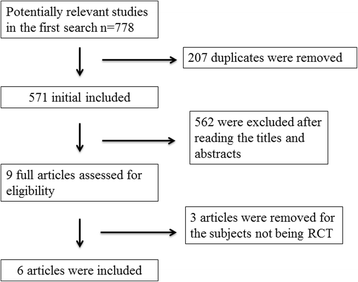The effect of midazolam on pain control after knee arthroscopy: a systematic review and meta-analysis
- PMID: 29162135
- PMCID: PMC5697077
- DOI: 10.1186/s13018-017-0682-0
The effect of midazolam on pain control after knee arthroscopy: a systematic review and meta-analysis
Abstract
Background: Midazolam has some potential in pain control of patients undergoing knee arthroscopy. However, the results remain controversial. We conduct a systematic review and meta-analysis to explore the effect of midazolam on pain control after knee arthroscopy.
Methods: PubMed, EMbase, Web of science, EBSCO, and Cochrane library databases are systematically searched. Randomized controlled trials (RCTs) assessing the effect of midazolam on pain management after knee arthroscopy are included. Two investigators have independently searched articles, extracted the data, and assessed the quality of the included studies. This meta-analysis is performed using the random-effect model.
Results: Six RCTs are included in this meta-analysis. Compared with control intervention after knee arthroscopy, midazolam intervention can significantly reduce the pain scores (standard mean difference (Std. MD) = - 3.70; 95% confidence interval (CI) = - 6.81 to - 0.60; P = 0.02), the number of patients requiring analgesics (risk ratio (RR) = 0.66; 95% CI = 0.49 to 0.88; P = 0.005), and analgesic consumption (Std. MD = -1.62; 95% CI = - 3.04 to - 0.19; P = 0.03), as well as increase the time to first analgesic requirement (Std. MD = 1.58; 95% CI = 0.17 to 2.99; P = 0.03). In addition, midazolam intervention results in no increase in adverse events following knee arthroscopy (RR = 0.74; 95% CI = 0.18 to 2.98; P = 0.67).
Conclusions: Midazolam intervention is revealed to substantially reduce the pain scores, the number of patients requiring analgesics, and analgesic consumption, as well as improve the time to first analgesic requirement after knee arthroscopy.
Keywords: Knee arthroscopy; Meta-analysis; Midazolam; Pain control; Pain scores.
Conflict of interest statement
Ethics approval and consent to participate
Not applicable.
Consent for publication
Not applicable.
Competing interests
The authors declare that they have no competing interests.
Publisher’s Note
Springer Nature remains neutral with regard to jurisdictional claims in published maps and institutional affiliations.
Figures






Similar articles
-
Continuous intravenous perioperative lidocaine infusion for postoperative pain and recovery in adults.Cochrane Database Syst Rev. 2018 Jun 4;6(6):CD009642. doi: 10.1002/14651858.CD009642.pub3. Cochrane Database Syst Rev. 2018. PMID: 29864216 Free PMC article.
-
Efficacy of dexmedetomidine for pain management in knee arthroscopy: A systematic review and meta-analysis.Medicine (Baltimore). 2017 Oct;96(43):e7938. doi: 10.1097/MD.0000000000007938. Medicine (Baltimore). 2017. PMID: 29068980 Free PMC article.
-
Dexamethasone as an adjuvant to peripheral nerve block.Cochrane Database Syst Rev. 2017 Nov 9;11(11):CD011770. doi: 10.1002/14651858.CD011770.pub2. Cochrane Database Syst Rev. 2017. PMID: 29121400 Free PMC article.
-
Pharmacological interventions for pain relief during orthodontic treatment.Cochrane Database Syst Rev. 2017 Nov 28;11(11):CD003976. doi: 10.1002/14651858.CD003976.pub2. Cochrane Database Syst Rev. 2017. PMID: 29182798 Free PMC article.
-
Arthroscopic surgery for degenerative knee disease (osteoarthritis including degenerative meniscal tears).Cochrane Database Syst Rev. 2022 Mar 3;3(3):CD014328. doi: 10.1002/14651858.CD014328. Cochrane Database Syst Rev. 2022. PMID: 35238404 Free PMC article.
Cited by
-
The efficacy of ketamine supplementation on pain management for knee arthroscopy: A meta-analysis of randomized controlled trials.Medicine (Baltimore). 2019 Jul;98(27):e16138. doi: 10.1097/MD.0000000000016138. Medicine (Baltimore). 2019. PMID: 31277113 Free PMC article.
-
Efficacy of intra-articular ketorolac for pain control in arthroscopic surgeries: a systematic review and meta-analysis.J Orthop Surg Res. 2021 Nov 22;16(1):688. doi: 10.1186/s13018-021-02833-4. J Orthop Surg Res. 2021. PMID: 34809647 Free PMC article.
-
Efficacy and safety of intra-articular glucocorticoid injection for postoperative pain control after knee arthroscopy: a systematic review.J Orthop Surg Res. 2024 Nov 7;19(1):736. doi: 10.1186/s13018-024-05204-x. J Orthop Surg Res. 2024. PMID: 39511598 Free PMC article.
-
The efficacy of celecoxib for pain management of arthroscopy: A meta-analysis of randomized controlled trials.Medicine (Baltimore). 2019 Dec;98(49):e17808. doi: 10.1097/MD.0000000000017808. Medicine (Baltimore). 2019. PMID: 31804304 Free PMC article.
-
Efficacy of Pre-Treatment with Remimazolam on Prevention of Propofol-Induced Injection Pain in Patients Undergoing Abortion or Curettage: A Prospective, Double-Blinded, Randomized and Placebo-Controlled Clinical Trial.Drug Des Devel Ther. 2021 Nov 4;15:4551-4558. doi: 10.2147/DDDT.S334100. eCollection 2021. Drug Des Devel Ther. 2021. PMID: 34764637 Free PMC article. Clinical Trial.
References
-
- Chou R, Gordon DB, de Leon-Casasola OA, Rosenberg JM, Bickler S, Brennan T, et al. Management of postoperative pain: a clinical practice guideline from the American Pain Society, the American Society of Regional Anesthesia and Pain Medicine, and the American Society of Anesthesiologists’ Committee on Regional Anesthesia, Executive Committee, and Administrative Council. J Pain. 2016;17:131–157. doi: 10.1016/j.jpain.2015.12.008. - DOI - PubMed
-
- Gordon DB, de Leon-Casasola OA, Wu CL, Sluka KA, Brennan TJ, Chou R. Research gaps in practice guidelines for acute postoperative pain management in adults: findings from a review of the evidence for an American Pain Society Clinical Practice Guideline. J Pain. 2016;17:158–166. doi: 10.1016/j.jpain.2015.10.023. - DOI - PubMed
Publication types
MeSH terms
Substances
LinkOut - more resources
Full Text Sources
Other Literature Sources
Research Materials

